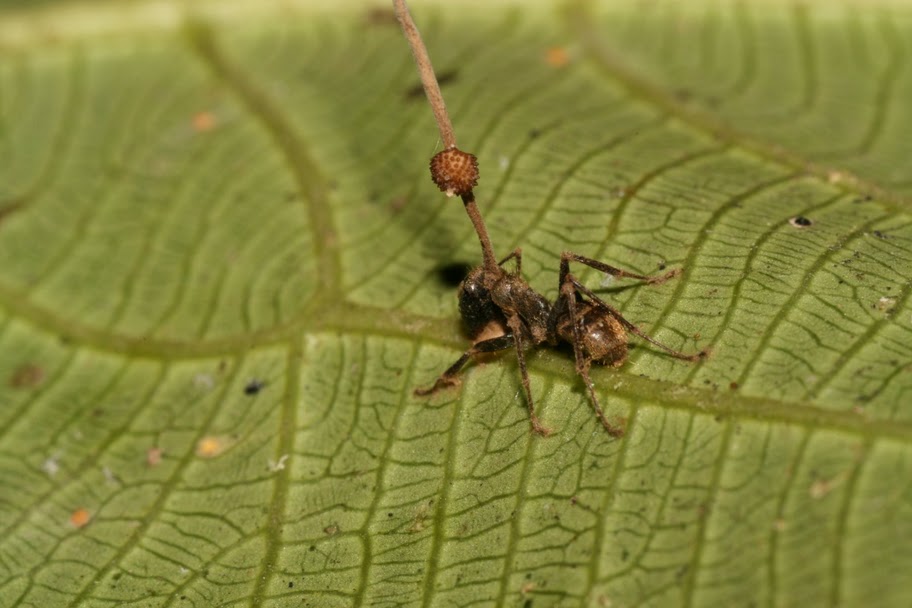How Zombie Ants Lose Their Minds

New gruesome details have emerged explaining how a parasitic fungus manipulates an unfortunate ant, filling its head with fungal cells and changing its muscles so the ant can grab a leaf in a death grip just when and where the fungus wants it.
Research in a Thai rain forest has shown the fungi, a species of Ophiocordyceps, forces an infected ant to wander drunkenly over the forest's low leaves before clamping its jaws around the main vein on the underside of a leaf in an ant zombie graveyard. [Mind Control: Gallery of Zombie Ants]
By watching 16 infected ants bite down, the researchers found that their last bites took place around noon, indicating they are synchronized to either the sun or a related cue, like temperature or humidity.
"Synchronized arrival of zombie ants at the graveyards is a remarkable phenomenon. It adds a layer of complexity on what is already an impressive feat," wrote David Hughes, a study researcher from Pennsylvania State University, in an email to LiveScience. "However, although ants bite at noon they don't in fact die until sunset. Likely this strategy ensures (the fungus) has a long cool night ahead of it during which time it can literally burst out of the ant's head to begin the growth of the spore-releasing stalk"
The bizarre sequence that leads up to the ant's death is completely out of step with its normal behavior and appears to be a way for the fungus to get itself to the perfect spot to spread its spores, according to the researchers.
The ants, a species called Camponotus leonardi, live in the canopies of trees, but come to the ground occasionally, where they contract the fungus. Healthy ants travel on trails unlike infected ones, which zigzag in a drunken walk over low vegetation, sometimes falling and convulsing before taking their final bite.
Hughes and colleagues observed a total of 42 infected ants, some of which they dissected. While holding its death grip, the ant's head was filled with fungal cells and the muscles that operated the ant's mandible, or jaw, was atrophied, they found.
Get the world’s most fascinating discoveries delivered straight to your inbox.
"In the context of biting, it allows the mandibles, we feel, to work in one direction and one direction only," Hughes told LiveScience. "Normally, they open and close, but in this case they can only close."
This keeps the dying ant from losing its grip. The fungus also appears to suck all of the calcium out of the muscles, causing a condition similar to rigor mortis, he said.
Fungi have been observed to manipulate the behavior arthropods as well, including crickets, bees, wasps and perhaps even spiders.
"We are quite confident we could see this and similar phenomenon across a broad range of organisms, because it is such a neat evolutionary trick if you are fungus to use the muscles of an animal to transport you to another environment," he wrote. (Many fungi rely on wind or other means to passively disperse their spores.)
More broadly, many parasites -- be they plant, animal or virus -- can alter the behavior of their hosts.
In the most recent study, published in the journal BMC Ecology, Hughes and colleagues observed and examined healthy and infected ants to compare their movements and reveal the physiological effects of the fungus. In a previous study, published in 2009, they found that the fungus manipulates infected ants to take it to ideal places for it to reproduce in the forest understory. As result the dead ants wound up on leaves on the north-northwestern side of plants approximately 9.8 inches (25 centimeters) above the ground.
You can follow LiveScience writer Wynne Parry on Twitter @Wynne_Parry. Follow LiveScience for the latest in science news and discoveries on Twitter @livescience and on Facebook.



